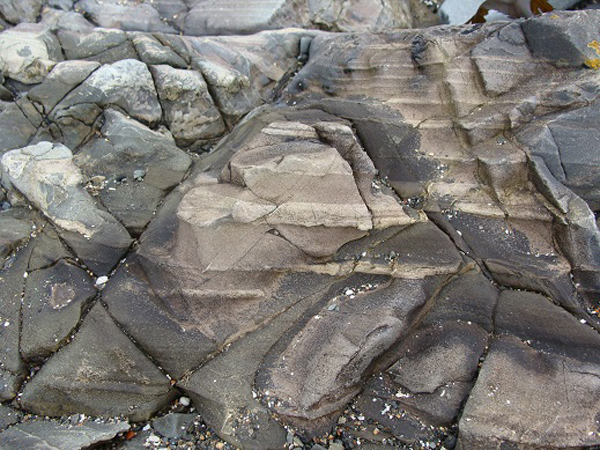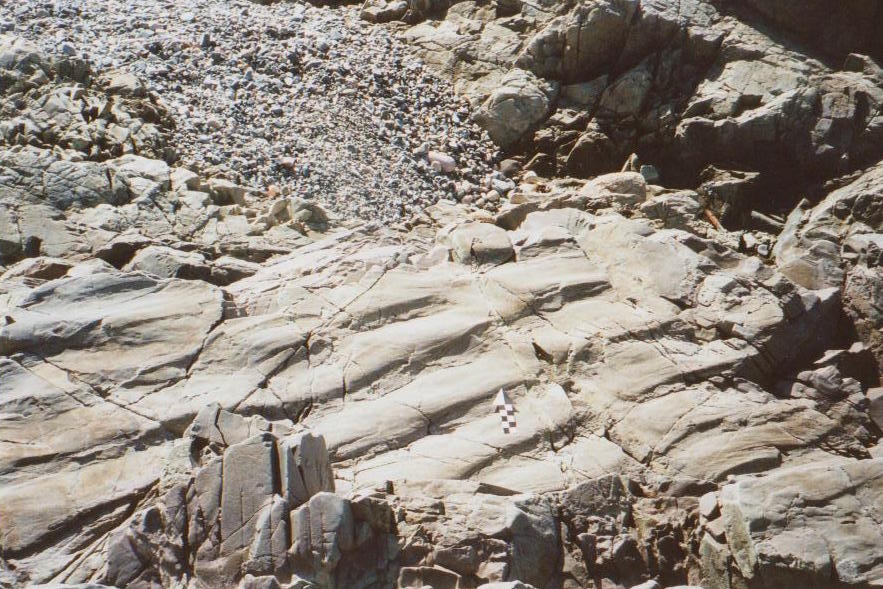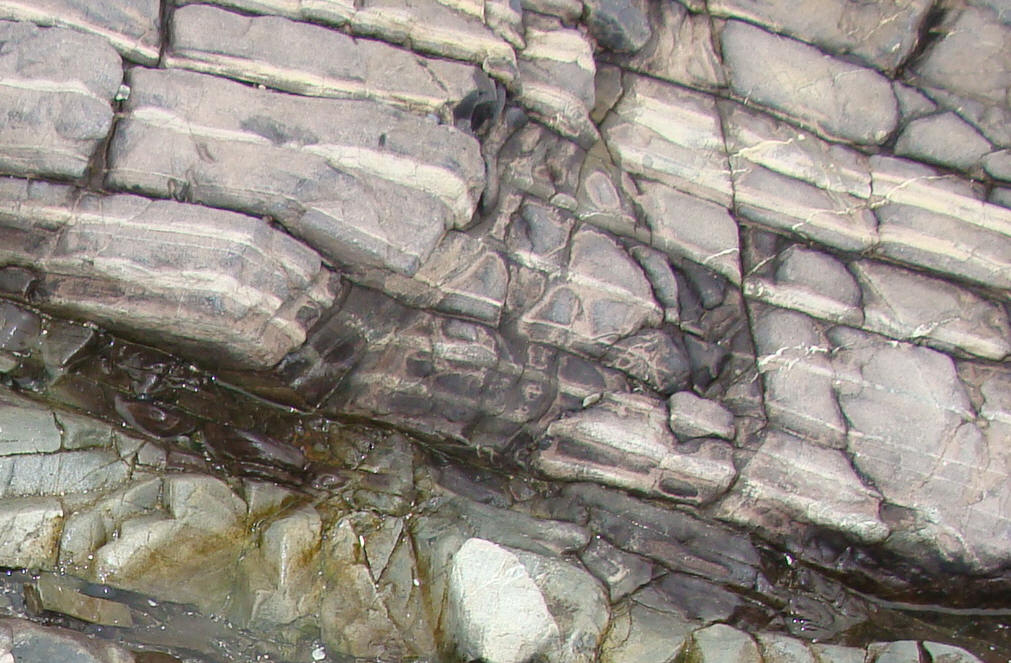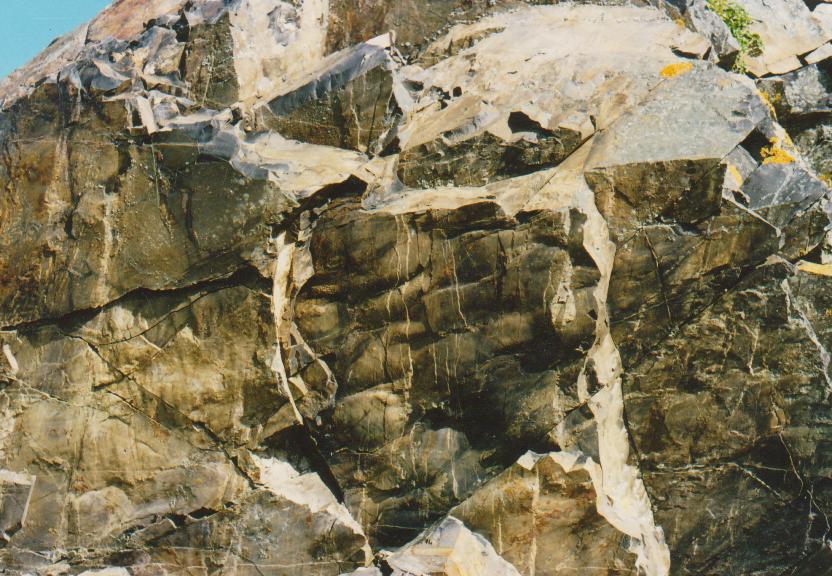|
|
Jersey Geology Trail |
Sandstone & Greywacke. (Old Saxon. sand=sand, stein=stone; Germ. grau=grey, wacko=pebble). |
 |
| |
Sandstones (arenites) are sedimentary rocks composed of sand size clasts (grains) between 62.5 µm (1/16m) and 2000 µm (2mm) in size (Udden - Wentworth Scale). Subdivisions into fine, medium and coarse sandstones can be based on the following size ranges, 60-200 μm; 200-600 µm and 600-2000 µm respectively (British Classification). The composition is generally quartz but can also be mixtures of quartz, feldspar and micas, eg. in an arkose (a quartzo-feldspathic sandstone), or quartz and rock fragments, eg. greywackes or lithic sandstones. The matrix can vary from calcite to silica, iron or clay.
The widely used Dott classification divides sandstones into various types of 'arenites' according to percentages of their dominant grain, eg. quartz, feldspar or rock fragments, and 'wackes' according to their percentages of quartz, feldspar or rock fragments and clay matrix (Allaby & Allaby, p. 168).
Various other terms are used to describe shape, rounding, size sorting and percentage of grains to matrix/cement. Analysing these features helps to interpret the environment of deposition.
Greywackes are sandstones composed of quartz, feldspar and lithic (rock) fragments with >15% clay minerals as matrix. describe the other features.
In Jersey, sandstones and greywackes are interbedded with shales of the Jersey Shale Formation and therefore have the same outcrop extent. The greywackes and shales are the oldest rocks and belong to the Upper Brioverian Group (Upper Proterozoic part of the Precambrian in age) which also crop out in Brittany and Normandy. They are considered to have been deposited between 680- 570 Ma ago (Bishop & Bisson, 1989, p. 5) as they are intruded by the oldest Jersey granite, the Dicq/Longueville granite dated at 570 Ma (recalculated from 580 Ma) but are dated at 585-540 Ma in Normandy by Guerrot & Peucat (1990, p.13). |
| |
 |
 |
Ripple laminated greywackes, Le Pulec. |
Ripple laminae (sole), Le Mont Matthieu. |
| |
They are exposed in the cliffs of Le Pulec and in the foreshore outcrops (with the shales) and are also found in road cuttings and quarries inland, eg. along La Vallée de St. Pierre and in the cutting up Le Mont Felard (not an easy place to stop and study). They are also well exposed along the beach and low cliff sections of the coast south of St. Aubin's Harbour. They occur as striking light grey and occasionally purple thin beds, 1-2mm thick. They are graded and laminated with the laminae often showing cross-bedding. In some cases they are ripple laminated, outcrops of which occur on the beach below the car park at Le Pulec and in a small quarry alongside the road up Le Mont Matthieu, St. Ouën, part of the fossil cliff line. Down the slipway onto the St. Ouën's bay beach, and against the sea wall for 50m east of the slipway, there is an excellent outcrop of several beds showing a variety of sedimentary structures, varying from cut and fill to load casts, cross-bedding, attenuated (pinch and swell), separated (sedimentary boudinage) and slumped beds. Possible examples of transport or thin, rectangular boudins (Encyc. Brit. 2002. Vol. 2, p. 418) have not yet been found, but flake conglomerates also exist (John Renouf, pers. comm.). The beds strike c. NNW and should occur (if continuous) in the cliffs of Le Grand Étacquerel above the flute casts illustrated below. These types of structure and many others are beautifully illustrated and explained by J. R. Roberts (1996, pp.14-61). |
| |
 |
 |
Erosional and differential load structures. |
Pressure or gravity attenuated beds. |
| |
 |
 |
Scour sole markings. |
Slump and separation structures. |
| |
 |
|
Load, separation and slump structures. |
|
| |
They range from quartz-wacke (95% quartz) to greywacke (>15% clay minerals) and have a clast framework of 70% quartz, 10-15% microcline and plagioclase feldspar, and 2% magnetite, ilmenite and haematite with carbon flakes in a 10-20% matrix (Bishop & Bisson, 1989, p.7). Lithic fragments are not described, but various heavy minerals with provenances from a great variety of igneous and metamorphic rocks are also recorded (Squire, 1974), which along with the variety of pebbles in the intraformational conglomerates at the isolated exposures along the northern edge of the Formation's outcrop, indicate source area(s) of many different rock types. In the area around Le Pulec, they are spotted with cordierite-biotite patches because they occur within the thermal metamorphic aureole of the adjacent granite (see light grey beds in photos).
The sequence of many sets of graded, laminated and ripple-laminated sandstones and shales has been divided into Associations I, II, III & IV and these have been related to four environments within a submarine fan complex (Helm & Pickering, 1985, pp. 43-66) and further described by Bishop and Bisson (1989, p. 9). These are respectively an inner or upper fan (I) consisting of the conglomerates and a single, deep channel along the northern junction with the granite; a mid-fan (II) with migrating channels of deposition of various cross-bedded sandstones in lenses in St. Peter's Valley, within a mixed mid-fan to outer fan (III & IV) with transient channel deposits - fan fringe deposits. In the north western coastal parts of the outcrop area (L'Étacq) there are transient channel deposits in the lower part of the mid-fan (III) with examples of turbidites and slump bedding; and finally, typical outer fan sequences of lobe and fringe deposits (IV) along the western and eastern parts of the outcrop.
Current bedding directions show a northerly flow in Associations III and IV, but also an easterly and south easterly flow in Association II. Overall, the directions suggest flow down a north facing continental slope (Armorica) into a subduction zone where an oceanic plate (Celtic) was descending (Bishop & Bisson, 1989, p.9-12).
In addition to all this, metamorphic effects and fold styles and strikes can be studied as described on the relevant pages of this website. |
| |
|
References.
Allaby, A. and Allaby, M. 1990. A Dictionary of Earth Sciences. 2nd. Ed. Oxford University Press.
Bishop, A. C. and Bisson, G. 1989. Classical areas of British geology: Jersey: description of 1:25,000 Channel Islands Sheet 2. (London: HMSO for British Geological Survey.)
Encyc. Brit. Eds. 2002. Boudinage. Vol. 2, p. 418.
Guerrot, C. & Peucat, J. J. 1990. U-Pb geochronology of the Upper proterozoic Cadomian Orogeny in the northern Armorican Massif, France. pp. 13-26. In D'Lemos. R. S., Strachan. R. A. and Topley. C. G. Eds. 1990. The Cadomian Orogeny. Geol. Soc. Spec. Publ. No. 51. The Geological Society. London.
Helm, D. G. & Pickering, K. T. 1985. The Jersey Shale Formation - a late Precambrian deep-water siliciclastic system, Jersey, Channel Islands. Sediment. Geol. Vol. 43. pp. 43 - 66.
Roberts, J. L. 1996. The Macmillan Field Guide to Geological Structures. Macmillan Reference Books, Macmillan Publishers Ltd. London and Basingstoke. |
| |
| |
| |
|